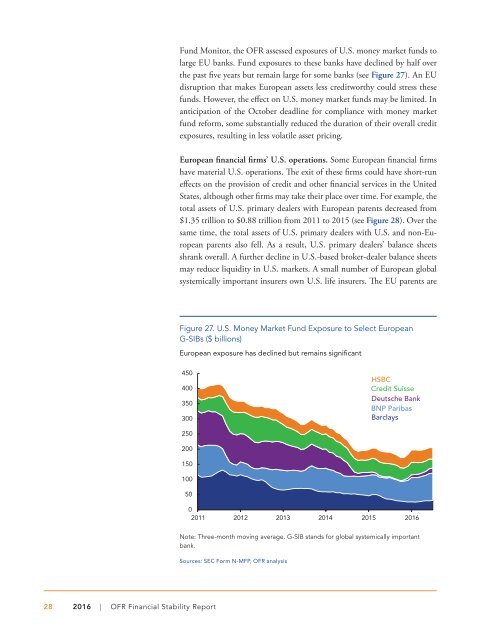OFR_2016_Financial-Stability-Report
OFR_2016_Financial-Stability-Report
OFR_2016_Financial-Stability-Report
You also want an ePaper? Increase the reach of your titles
YUMPU automatically turns print PDFs into web optimized ePapers that Google loves.
Fund Monitor, the <strong>OFR</strong> assessed exposures of U.S. money market funds to<br />
large EU banks. Fund exposures to these banks have declined by half over<br />
the past five years but remain large for some banks (see Figure 27). An EU<br />
disruption that makes European assets less creditworthy could stress these<br />
funds. However, the effect on U.S. money market funds may be limited. In<br />
anticipation of the October deadline for compliance with money market<br />
fund reform, some substantially reduced the duration of their overall credit<br />
exposures, resulting in less volatile asset pricing.<br />
European financial firms’ U.S. operations. Some European financial firms<br />
have material U.S. operations. The exit of these firms could have short-run<br />
effects on the provision of credit and other financial services in the United<br />
States, although other firms may take their place over time. For example, the<br />
total assets of U.S. primary dealers with European parents decreased from<br />
$1.35 trillion to $0.88 trillion from 2011 to 2015 (see Figure 28). Over the<br />
same time, the total assets of U.S. primary dealers with U.S. and non-European<br />
parents also fell. As a result, U.S. primary dealers’ balance sheets<br />
shrank overall. A further decline in U.S.-based broker-dealer balance sheets<br />
may reduce liquidity in U.S. markets. A small number of European global<br />
systemically important insurers own U.S. life insurers. The EU parents are<br />
Figure 27. U.S. Money Market Fund Exposure to Select European<br />
G-SIBs ($ billions)<br />
European exposure has declined but remains significant<br />
450<br />
400<br />
350<br />
300<br />
HSBC<br />
Credit Suisse<br />
Deutsche Bank<br />
BNP Paribas<br />
Barclays<br />
250<br />
200<br />
150<br />
100<br />
50<br />
0<br />
2011 2012 2013 2014 2015 <strong>2016</strong><br />
Note: Three-month moving average. G-SIB stands for global systemically important<br />
bank.<br />
Sources: SEC Form N-MFP, <strong>OFR</strong> analysis<br />
28 <strong>2016</strong> | <strong>OFR</strong> <strong>Financial</strong> <strong>Stability</strong> <strong>Report</strong>


